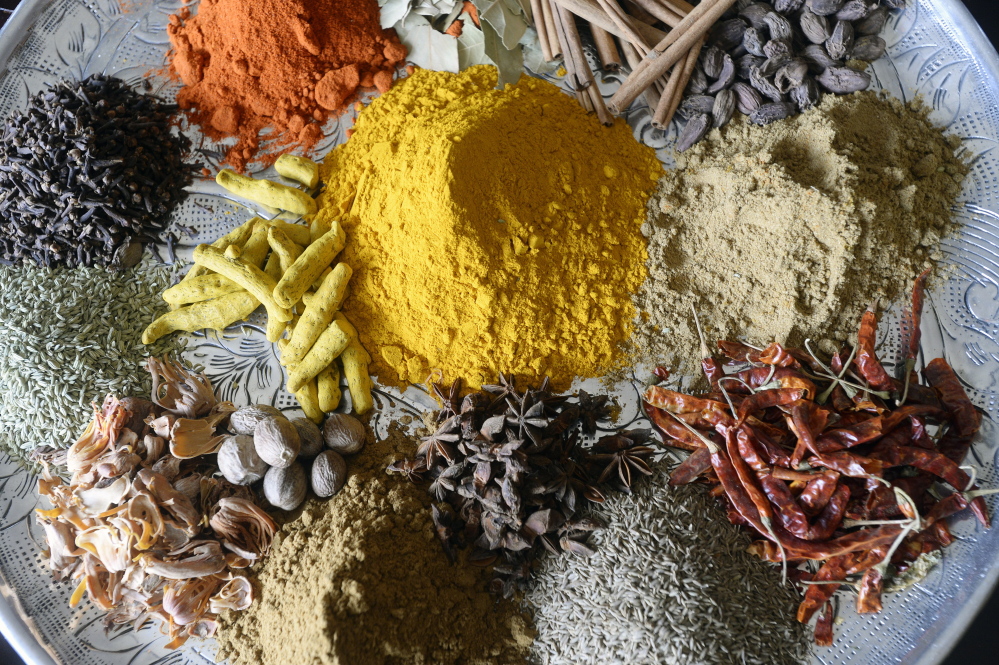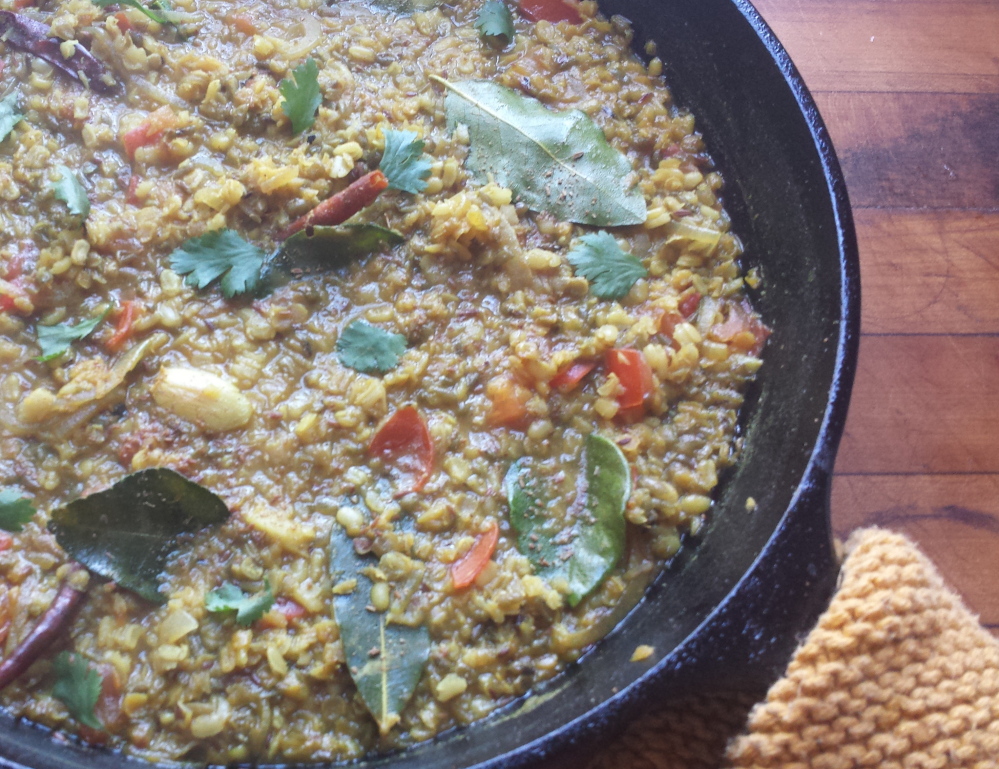When I was a child, my mother had a lazy Susan whose only whirling passengers were red, white and blue tins of McCormick herbs and spices. Some still ride that culinary merry-go-round 40 years on. That makes me smile with nostalgia, even though I know those ingredients will provide little kick to the dishes I cook in her kitchen.
Spices have a limited shelf life. They don’t go bad. They go bland.
The folks at McCormick say ground spices (nutmeg, cinnamon, turmeric) are good for two to three years; dried herbs (basil, oregano, parsley) for one to three years; and whole spices (cloves, peppercorns, cinnamon sticks) for four years. After these dates, the company suggests you toss them. Most chefs I’ve asked recommend keeping ground spices for no longer than six months and whole ones for a year.
Buying spices from the bulk bins in whole foods stores, ethnic groceries or from online spice retailers can be a greener, cheaper and tastier option for home cooks.
Greener in the sense that you will bypass packaging materials and reduce the amount of wasted spices, 80 percent of which carry a carbon footprint from exotic, far-flung places like India, Guatemala and Vietnam.
The USDA has tracked the spice import market since 1966. Then, the annual tally of spices brought into the United States was 1.2 pounds per capita. It now stands at 3.5 pounds per capita, driven by increased demand for chili peppers, cinnamon, ginger, fennel seed, mustard seed, paprika and turmeric. Allowing for 60 percent of those spices having been consumed in restaurants, my calculations show the potential for 13 spice containers to be sold to every citizen annually. Bringing my own four-member family’s spice jars to the bulk bins when they need refilling pulls 52 spice containers out of the waste stream annually.
Chef Raj Mandekar of Tulsi in Kittery says health and safety codes require him to store bulk spices in his Indian restaurant in plastic containers. He regularly employs over 30 spices in his cooking, which add up fast, so the 50-pound bags of spices he buys from Boston purveyors don’t last long in his commercial kitchen.
At home, Mandekar prefers to store small amounts of spices in glass jars, as plastic pulls the flavor from spices, decreasing their potency over time. Mandekar also recommends using small jars with very little head room, as air can oxidize a spice, decreasing flavor, and keeping them in dark, dry places, as light and moisture also weaken a spice’s, well, spice.
Buying bulk spices is also less expensive. A check of the price per ounce at a local grocery store shows packaged black peppercorns cost $2.24; cumin seeds $3.36; and ground ginger $2.62, while they cost $1.58, $1.22 and $1.62 per ounce, respectively, in the bulk bin at a local health foods store.
Additional savings come when you work with a recipe that calls for a spice you rarely use (say the asafetida powder in Mandekar’s yellow dal recipe below), and you can buy only the amount you need.
Keeping your spices’ flavor at their peak is one step in adequately flavoring dishes. Another, Mandekar contends, is layering flavors. For example, he advises using ground bulk spices in the early part of cooking a curry, to provide a mellow, base flavor profile for the stew. But just before serving, he suggests toasting and freshly grinding whole spices, processes that deepen their flavors, and adding a pinch of these spices to the dal just before serving it.
“That last step changes the whole dynamic of the dish,” Mandekar said, adding “always for the better.”
MASOOR MOONG DAL
While this recipe from chef Raj Mandekar of Tulsi in Kittery requires quite a few ingredients, buying spices (and beans) in small quantities from the bulk bins cuts down on unnecessary packaging. You can find asafetida and curry leaves in Indian and Asian markets in Portland and Portsmouth. To prepare the cumin, place the whole seeds in a dry skillet over medium high heat. As soon as you smell the cumin, remove the skillet from the burner. Pour the seeds into a spice grinder (I use a small Krups coffee grinder) or a mortar and pestle and grind them to a fine powder.
Serves 6
½ cup moong dal (dried, skinned, split yellow mung beans)
½ cup masoor dal (dried, split red lentils)
1½ tablespoons vegetable oil
2 teaspoons whole cumin seeds
4 whole, dried chili peppers (lal mirch, small reddish brown chilis)
4 cloves garlic, crushed
½ teaspoon asafetida powder
½ cup thinly sliced yellow onion
1 teaspoon turmeric
2 tablespoons chopped jalapeño chilies (optional)
10 fresh curry leaves
4 dried bay leaves
½ cup chopped fresh tomatoes
1 teaspoon kosher salt
½ teaspoon freshly toasted and finely ground cumin powder
½ cup chopped cilantro leaves
Bring 5 cups of water to a boil in a large saucepan over high heat. Add the moong and masoor dal. Cook for 10 minutes, skimming any foam from the top. Set aside.
Place a medium skillet over medium high heat and add the oil. When the oil is hot, add cumin seeds and dried chili peppers and let them sizzle briefly, 5 to 7 seconds; the chilies will turn black. Immediately add the garlic and cook until lightly brown, about 30 seconds. Add the asafetida and onions. Cook the onions until they are golden brown, 3 to 4 minutes.
Remove the pan from the heat, add the turmeric, jalapeño chilies (if using), curry and bay leaves. Return the pan to medium high heat, and cook for 2 minutes. Add the tomatoes and cook them until they soften but do not completely lose their shape, about 2 minutes.
Add the onion, tomato and spice mixture to the dal pot. Stir in the salt. Bring to a simmer and cook until the dal are softened, 10 to 12 minutes. If you like them quite soft, you may need to add more water and let them cook longer.
Just before serving, stir in the freshly toasted and finely ground cumin powder. Garnish the dal with chopped cilantro leaves and serve hot.
Christine Burns Rudalevige is a food writer, recipe developer and tester, and cooking teacher in Brunswick. She writes about feeding her family Maine seafood at www.familyfish.net. Contact her at cburns1227@gmail.com.
Copy the Story LinkSend questions/comments to the editors.




Success. Please wait for the page to reload. If the page does not reload within 5 seconds, please refresh the page.
Enter your email and password to access comments.
Hi, to comment on stories you must . This profile is in addition to your subscription and website login.
Already have a commenting profile? .
Invalid username/password.
Please check your email to confirm and complete your registration.
Only subscribers are eligible to post comments. Please subscribe or login first for digital access. Here’s why.
Use the form below to reset your password. When you've submitted your account email, we will send an email with a reset code.